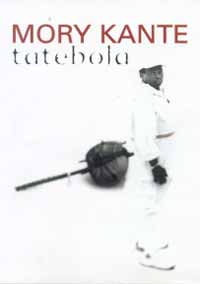|
||||
|
After the great success of "Yéké Yéké", Mory Kanté had difficulties to maintain in his role of super star of world music. But two years ago (2001), he came back with a hit "Tamala" or the traveller. An album that almost seals the destiny of the traveller he is. An excellent work which distributed in Mali thanks to Mali K7. Mory Kanté was born on February 24th, 1950 in the middle of the Mandingo Empire in a small village of the south of Guinea called Albadaria; it’s near Kissidougou. His father El Hadj Djelifodé Kanté is already a very old man at the birth of Mory who is one of the youngest of his 38 children. The Kanté family is a famous family of griots, kind of poets, singers, historians and journalist at the same time. They are real alive memories which role is to recount the no ending epics of the families and peoples. Mory‘s father and mother are both griots (it’s an hereditary function) and his maternal grand father was a powerful griots’ chief leading a powerful clan. So the destiny of the child is simply to become a “djeli”, Mandingo word for “griot”. Mory first grew up near his Malian mother Fatouma Kamissoko then went to French school. At 7 years old, his family sent him to Bamako, (capital of Mali) where his aunt Mananba Kamissoko leaves, she, also, was a famous griot. Up to 15 years old, he’s taught the traditional rituals, how to sing and how to play Balafon (African sort of xylophone). He takes part in many familial feasts, in official ceremonial during which he got a strong experience of singer and musician. During the sixties, the young republic of Mali receives a lot of musical influences: Zairian rumba, Cuban salsa, Anglo-Saxons’ pop and rock. The young Mory quickly get a passion for this new electrical music and learn how to play the guitar. With his strong traditional experience, he goes toward certain modernity very far from his familial surroundings. In 1968, he leaves school to integrate the arts institute of Bamako. But in 1969, he stops his formation and plays in different orchestras. He gets fame first through making Malian dance for whole nights in open-air parties. It was the time of the "apollos".
“My step since the beginning is to go toward an inter-cultural communication and to give a position to the African instruments in the universal tree of music. It does work. Now every body knows the Balafon and the Kora, they are some times integrated in the band which plays fusion music. Today the African traditional music is known and appreciated in the world, to me, the goal is reached” said Mory. He exercises his talent of composer by writing pieces of music for chorus and ballets. He records with the Rail Band a long epic in the tradition of the griots, “the exile of Soundiata, the creator of the Mandingo Empire”. In 1977, he undertakes, in a personal capacity, the tour of the great historical sites of the empire during which he meets a lot of masers of the tradition in order to perfect his role of griot. Despite the modern variations he imposes to musical tradition, Mory Kanté will never put aside his familial heredity. In 1978, Mory is installed in Abidjan in Ivory Coast; it’s a town which is musically very active and where the means to records are more numerous. The musician then move away from the Rail Band. He then surrounds himself with new musicians among which Djeli Moussa Diawara. From then on the Kora is the centre of his work. More over, he dreams to renew the traditional music by introducing occidental rhythms and sound in it. The band is engaged by one of the biggest restaurant of the town which want to animate more originally its nights. It’s a good occasion for Mory Kante to experiment musical mixes never seen before. To the traditional tunes, he gives a rock or funk dressing, by the same way; he revisits the afro-American repertoires with the Kora, with djembé or with the bolon (African bass with three strings to which Mory added two more strings). The bases of a new style are here. The success is immediate even if the modernisation of traditional music is not always appreciated by his surrounding and the purist. It’s not rare to see the press of the time calling him the “the terrible child”. It’s
at Los Angeles; on the label of the afro-American Gerard Chess Ebony
that Mory Kante records his first album
in 1981, "Courougnègnè". The artist refines
his mixes of tradition and modernism, of traditional and electrical
instruments. Already very known in West Africa, Mory become a star
all over the continent. The bridge his created between Africa and
occident is generally good welcomed. Following this huge success,
he did a great ballet for the French cultural centre of Abidjan. On
the stage, people could see 75 artists: a chorus, musicians and dancers.
During the following years Mory make concerts regularly with an orchestra
of almost 20 musicians. But it’s in Europe that the musician
wants to work. It’s in Italy that he meets the American producer David Sancious who became well-known when he was working with Bruce Springsteen. The union of their two talents leads to the third album "Ten Cola Nuts" which is released in April 1986 on the French label Barclay. These cola nuts represent the ritual offering and the wishes of happiness. The Kora is always in the centre of the album, but the synthesizers and the brass instruments come to enrich the ensemble. The work is perfect and qualified of a sublime success by the press. The sale rates are medium but this time, Mory Kante has found a musical and cultural balance. Just after the death of his father at more than 100 years old, the young Guinean griot begin a long tour with a first concert at the Zénith of Paris on may 29th. In June, he passes in Ivory Coast and in Senegal where he takes part in an anti-apartheid manifestation organised on June 14th, on the island of Gorée, island of the slaves off Dakar. Followed tours in Europe, united states and almost every where in the world (Japan, Australia...).The band accompanying him is like his music; very mixed because composed of Malian, Senegalese, south-African, French, English, Sweden people who all share their culture and experiences. Electrical
griot
The afro-dance
records his new album “Nongo Village” called like his
studio in his country, in guinea. Among the tracks mixed in New York
and Paris, the track "La Tension" seems to be the one which
will conquer the dancing room like "Yéké Yéké”.
On this album, Mory Kanté returns
to Balafon
thus supplanting the guitars. The first extract is in the back in
September 93 followed by the album at the autumn. It’s not goodly
welcomed and some reproach him to lose himself in recipe which needs
renewal. But in 1994, Mory Kanté
receives the “Golden Griot”. Allowances
“Tamala summarizes my life because I travelled a lot. The griot always travels a lot from village to village, from region to region, from country to country; it’s a communicator, an informer. The word “griot” is the translation in French of the Mandingo word “jail” which means “blood”; as the blood floods everywhere in the body that he knows very well. The jail is the one who knows very well our Mandingo society and perpetuate the the historical, cultural and economical realities” he explains in an interview with RFI. To him, in spite of the socio-cultural mutations, “the Mandingo countries are fond of their culture and civilisation and have always given an important place to the griot. Still today, griots are consulted in Mali and guinea y the national assembly for great decisions. We know that they are the memory which conserves the past and present events. They also have their place in the wedding. They are not profiteer as some say; their goal has never be to enrich themselves on the others”. It seems that in his career, the success of "Yéké Yéké” is the one that marked him the most. “Yéké Yéké is still appreciated today (that pleases me a lot) because Leonardo di Caprio used one of it remix for the original soundtrack of his film The Beach. But I haven’t done only that and Yéké Yéké is just an aspect of the steps I made in order to valorise traditional instruments. It’s my real goal and Tamala (my new album) has the same goal: build a bridge between tradition, authentic music and modern world”. King Moseto |
||||

 Mory
Kanté Artist
Mory
Kanté Artist In
1971, Mory is 21. He’s remarked by the saxophone player Tidiane
Koné who proposed him to integrate his band the
In
1971, Mory is 21. He’s remarked by the saxophone player Tidiane
Koné who proposed him to integrate his band the  From
dream to reality
From
dream to reality In
January 1990, he’s back in the studios in Brussels then in Los-Angeles
to record his album "Touma" ("the time"). For
the occasion and with his notoriety, he surrounds himself with celebrities
such as Carlos Santana, the Chicano American
guitar player very well known in Africa or the South African Ray
Phiri. The step is the same as for "Akwaba Beach"
and develops a subtle and sophisticated blend of pop and Mandingo
tradition. The album is released in September 1990. Suffering and
benefiting from the huge success of the preceding album, the sales
don’t exceed the golden record and hardly reaches the million
in foreign countries.
In
January 1990, he’s back in the studios in Brussels then in Los-Angeles
to record his album "Touma" ("the time"). For
the occasion and with his notoriety, he surrounds himself with celebrities
such as Carlos Santana, the Chicano American
guitar player very well known in Africa or the South African Ray
Phiri. The step is the same as for "Akwaba Beach"
and develops a subtle and sophisticated blend of pop and Mandingo
tradition. The album is released in September 1990. Suffering and
benefiting from the huge success of the preceding album, the sales
don’t exceed the golden record and hardly reaches the million
in foreign countries.